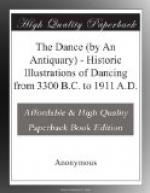The illustration (fig. 43) of a dance of angels and religious shows us that Fra Angelico thought the practice joyful; this dance is almost a counterpart of that amongst the Greeks (fig. 11). The other dance, by Sandro Botticelli (fig. 44), is taken from his celebrated “Nativity” in the National Gallery. Although we have records of performances in churches, no illustrations of an early date have come to the knowledge of the writer. [Illustration: Fig. 30.—Dancing to horn and pipe. From an Anglo-Saxon MS.]
That the original inhabitants of Britain danced—that the Picts, Danes, Saxons and Romans danced may be taken for granted, but there seems little doubt that our earliest illustrations of dancing were of the Roman tradition. We find the attitude, the instruments and the clapping of hands, all of the same undoubted classic character. Tacitus informs us that the Teutonic youths danced, with swords and spears, and Olaus Magnus that the Goths, &c., had military dances: still the military dances in English MSS. (figs. 31, 32) seem more like those of a Pyrrhic character, which Julius Caesar, the conqueror of England, introduced into Rome. The illustration (fig. 29) of what is probably a Saxon gleemen’s dance shows us the kind of amusement they afforded and how they followed classic usages.
[Illustration: Fig. 31.—Anglo-Saxon sword dance. From the MS. Cleopatra, C. viii., British Museum.] The gleemen were reciters, singers and dancers; and the lower orders were tumblers, sleight-of-hand men and general entertainers. What may have been the origin of our hornpipe is illustrated in fig. 30, where the figures dance to the sound of the horn in much the same attitudes as in the modern hornpipe, with a curious resemblance to the position in some Muscovite dances.
[Illustration: Fig. 32.—Sword dance to bagpipes, 14th century. From 2 B vii., Royal MS., British Museum.]
The Norman minstrel, successor of the gleeman, used the double-pipe, the harp, the viol, trumpets, the horn and a small flat drum, and it is not unlikely that from Sicily and their South Italian possessions the Normans introduced classic ideas.
Piers the Plowman used words of Norman extraction for them, as he speaks of their “Saylen and Saute.”
The minstrel and harpist does not appear to have danced very much, but to have left this to the joculator, and dancing and tumbling and even acrobatic women and dancers appear to have become common before the time of Chaucer’s “Tomblesteres.”
[Illustration: Fig. 33.—Herodias tumbling. From a MS. end of 13th century (Addl. 18,719, f. 253b), British Museum.]
That this tumbling and dancing was common in the thirteenth century is shown by the illustration from the sculpture at Rouen Cathedral (fig. 34), the illustrations from a MS. in the British Museum (fig. 33) of Herodias tumbling and of a design in glass in Lincoln, and other instances at Ely; Idsworth Church, Hants; Ponce, France, and elsewhere. It is suggested that the camp followers of the Crusaders brought back certain dances and amongst these some of an acrobatic nature, and many that were reprehensible, which brought down the anger of the Clergy.




